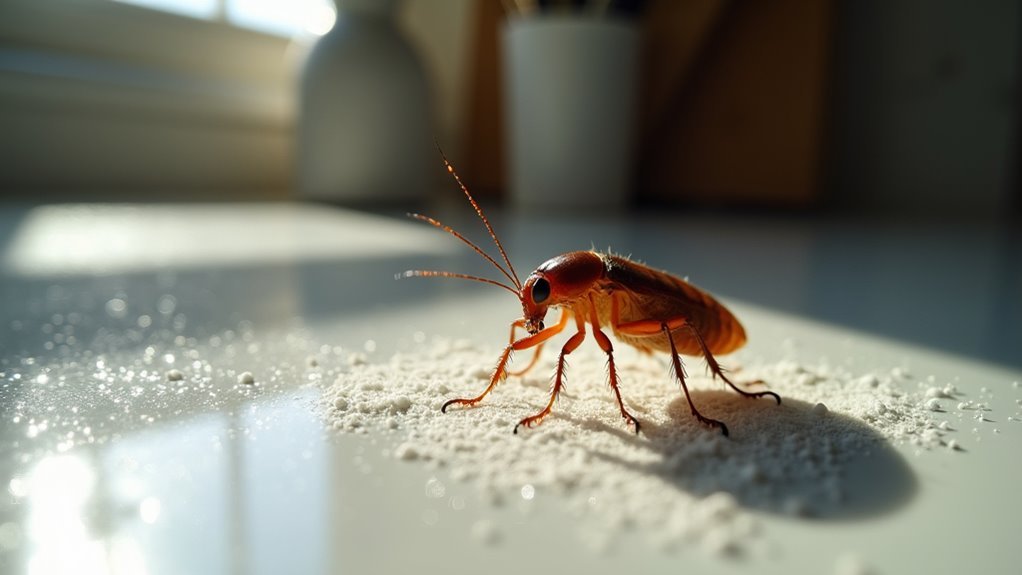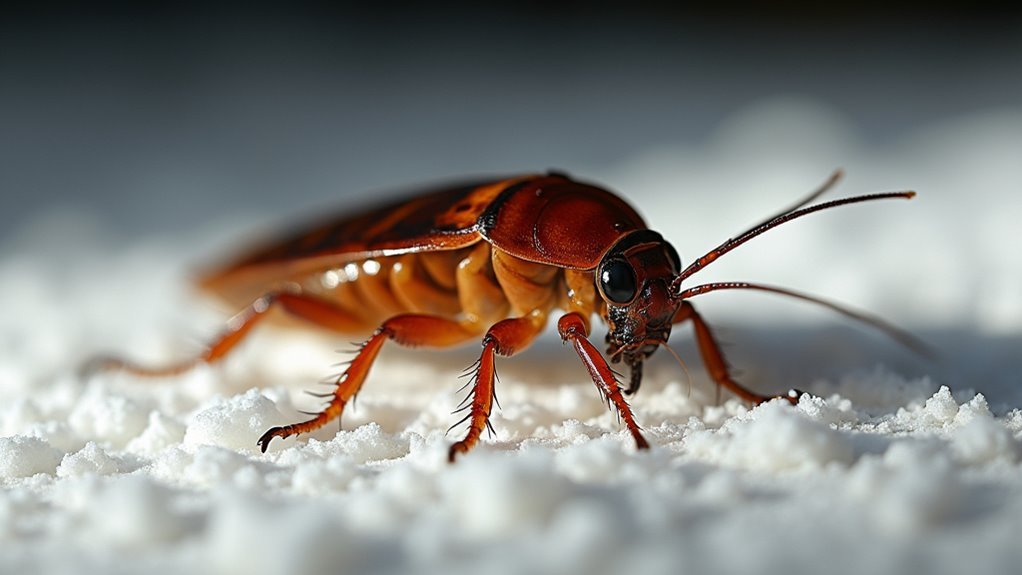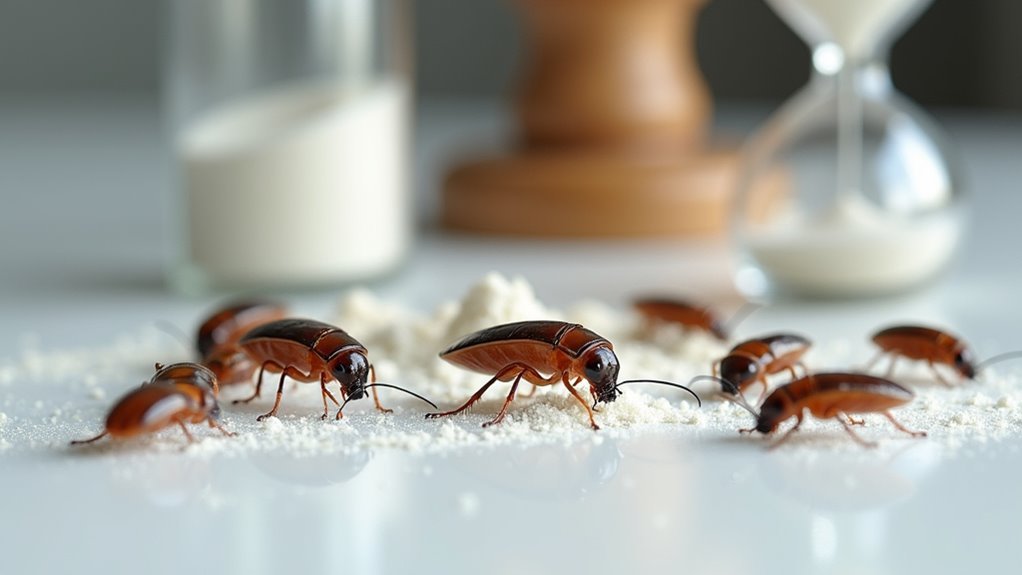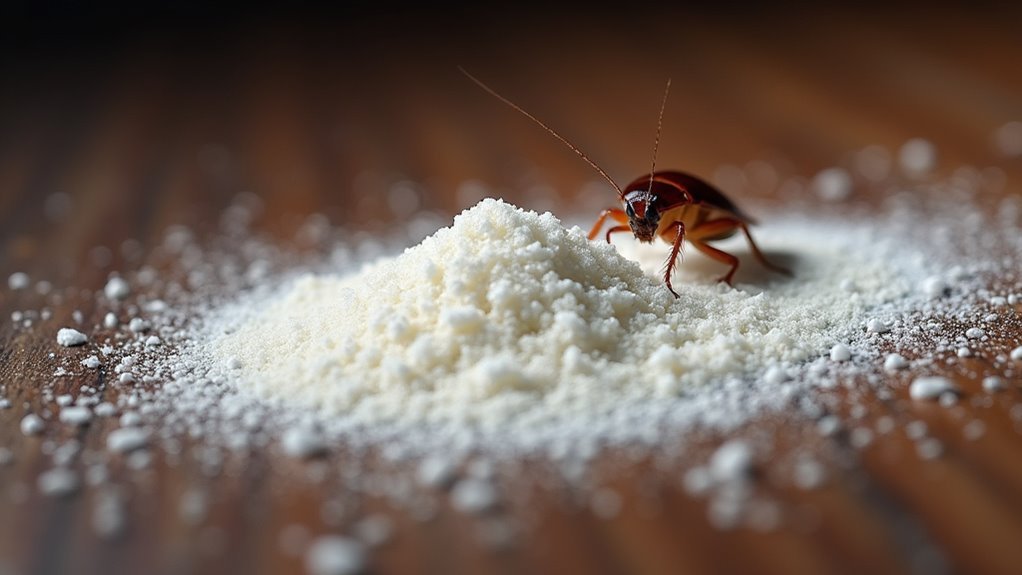Boric acid kills cockroaches through a triple-threat mechanism that you can’t escape once ingested. When cockroaches groom themselves, they consume the microscopic crystals that immediately disrupt their digestive system, preventing nutrient absorption and forcing them to stop feeding. The sharp crystals simultaneously damage their exoskeleton, causing rapid dehydration and water loss. Their nervous system shuts down as neurotransmitters fail, leading to paralysis and death within days. This multi-system approach guarantees cockroaches can’t develop resistance, and understanding these precise mechanisms will help you maximize your pest control strategy.
How Boric Acid Disrupts Cockroach Digestive Systems

Boric acid attacks cockroaches through a multi-pronged assault on their digestive systems, acting as a potent stomach poison that disrupts their metabolism and triggers a cascade of fatal physiological failures.
When you apply boric acid, cockroaches ingest it during their natural grooming behaviors. Once consumed, this stomach poison wreaks havoc on their nutrient absorption processes, preventing them from extracting essential nutrients from food.
Boric acid becomes lethal when cockroaches consume it while grooming, immediately disrupting their ability to absorb vital nutrients from food.
This metabolic disruption forces cockroaches to stop feeding as their bodies can’t process nutrients effectively. Simultaneously, boric acid’s desiccant properties damage their exoskeleton, causing severe dehydration that compounds digestive problems.
You’ll notice cockroaches become increasingly lethargic as their energy reserves deplete. The combination of impaired digestive system function and progressive dehydration creates a fatal cycle, ultimately killing cockroaches within days.
The Dehydration Process That Leads to Cockroach Death
Dehydration becomes the primary mechanism through which boric acid delivers its lethal blow to cockroaches, creating a relentless cycle that systematically shuts down their essential functions.
Once you’ve applied boric acid, ingestion disrupts the cockroach’s metabolic processes, immediately compromising their water retention capabilities. The digestive system can’t function normally, causing rapid water loss through their exoskeleton.
You’ll notice cockroaches desperately seeking water sources as dehydration accelerates. Their high surface area to volume ratio works against them, making water loss even more severe.
The metabolic disruption prevents proper hydration, even when they find water. Within days, this relentless dehydration cycle leads to death as their essential bodily functions completely shut down from water deprivation.
Nervous System Breakdown From Boric Acid Exposure

While dehydration devastates cockroaches from within, boric acid simultaneously launches a devastating assault on their nervous system that compounds their suffering.
When you apply boric acid, it disrupts neurotransmitter function throughout the cockroach’s body. This interference creates a cascading breakdown that affects their ability to coordinate movement and basic bodily functions.
The ingested boric acid works systematically to shut down neural pathways. You’ll notice cockroaches begin moving erratically as their nervous system fails. Paralysis gradually sets in as the toxin continues its destructive work.
Combined with moisture loss from the exoskeleton, this dual attack proves fatal. Boric acid kills through this extensive assault, making it impossible for cockroaches to maintain normal physiological processes or escape the toxic environment.
Why Cockroaches Cannot Develop Resistance to Boric Acid
You’ll find that cockroaches can’t develop resistance to boric acid because it attacks them through physical damage rather than just chemical disruption.
Unlike synthetic pesticides that target single biological pathways, boric acid simultaneously destroys their exoskeleton, digestive system, and nervous system through multiple mechanisms.
This multi-front assault makes it impossible for roaches to evolve defensive adaptations since they’d need to fundamentally change their basic anatomy and physiology.
Physical Mode Action
Boric acid cuts through cockroach defenses using a dual-action approach that makes resistance nearly impossible to develop. When you apply this powder, its microscopic crystals act like tiny razors that abrade the cockroaches’ exoskeleton. This physical damage disrupts their ability to retain moisture, causing severe dehydration that leads to death.
You’ll find that ingestion amplifies the effectiveness. As cockroaches groom themselves, they consume boric acid particles clinging to their bodies. This creates a toxic internal environment that disrupts their metabolic functions.
Since the acid works through both physical abrasion and chemical poisoning, cockroaches can’t adapt like they do with traditional insecticides. This dual mechanism guarantees boric acid remains effective against entire infestations, preventing resistant populations from establishing themselves.
Multiple Target Systems
Three distinct biological systems fall under attack when cockroaches encounter boric acid, creating an insurmountable challenge for these pests to overcome.
You’ll find that boric acid kills cockroaches by simultaneously targeting their digestive system, nervous system, and water regulation mechanisms. This multi-pronged assault through multiple mechanisms makes resistance development nearly impossible.
When cockroaches ingest boric acid during grooming, it disrupts their digestive processes while acting as a desiccant. The dehydration occurs rapidly as their bodies lose water control.
Meanwhile, their nervous system suffers interference, affecting coordination and basic functions. Unlike single-action pesticides that target systems individually, boric acid’s approach overwhelms cockroaches’ adaptive capabilities.
They can’t develop countermeasures against three simultaneous biological attacks, ensuring this treatment remains effective long-term.
Timeline of Cockroach Death After Boric Acid Contact

When cockroaches ingest this white powder, they won’t drop dead immediately like you might expect from other pesticides.
You’ll notice signs of infestation beginning to diminish within 24 to 48 hours as affected cockroaches show distress from disrupted digestive and nervous systems. The dehydration process proves most effective during this period, with adult cockroaches typically dying within three days post-exposure.
Your pest management strategy becomes even more powerful as poisoned roaches spread the toxicant to others through grooming and cannibalism. However, humid environments can extend this timeline beyond three days, reducing effectiveness.
Strategic placement of boric acid baits guarantees thorough cockroach control as the desiccant rapidly removes moisture from their bodies.
Secondary Elimination Through Grooming and Cannibalism
Beyond direct contact exposure, cockroaches unknowingly become carriers of their own destruction through natural behaviors that transform boric acid into a population-wide elimination system.
When roaches walk through boric acid powder, they’ll carry the lethal substance on their bodies. During self-grooming sessions, they ingest the toxicant, which disrupts their nervous and digestive systems, causing dehydration and death.
This secondary elimination process amplifies boric acid’s effectiveness through:
- Self-grooming contamination – Roaches consume boric acid while cleaning themselves
- Cannibalistic behavior – Living roaches eat poisoned corpses, ingesting more toxicant
- Cockroach excrement spreading – Contaminated waste further distributes the poison
- Population cascade effect – Multiple exposure routes accelerate colony elimination
This cannibalistic behavior creates a deadly cycle that extends far beyond initial contact, making boric acid exceptionally effective against roach infestations.
Microscopic Crystal Damage to Cockroach Exoskeletons
When you sprinkle boric acid around cockroach pathways, you’re deploying millions of microscopic crystals that act like tiny glass shards against their bodies.
These sharp-edged particles don’t just sit on the surface—they actively penetrate and slice through the cockroach’s protective exoskeleton as the insect moves through the powder.
You’ll find that this crystal structure creates multiple entry points that compromise the cockroach’s natural armor, setting up a cascade of damage that extends far beyond the initial contact.
Crystal Structure Effects
As boric acid particles settle onto a cockroach’s body, their microscopic crystal structure becomes a deadly weapon against the insect’s protective armor.
These razor-sharp crystals create an abrasive surface that systematically destroys the exoskeleton’s integrity through physical contact.
The crystal structure’s effectiveness in pest control stems from four key mechanisms:
- Sharp edges slice through the exoskeleton’s protective coating
- Multiple contact points maximize surface damage
- Persistent adherence guarantees continuous abrasion
- Microscopic size allows penetration into tiny crevices
You’ll find that once these crystals compromise the exoskeleton, moisture regulation becomes impossible.
The cockroach can’t maintain its internal water balance, leading to rapid dehydration.
This structural damage accelerates the death process, making boric acid’s crystal formation the primary factor in its lethal effectiveness against cockroaches.
Exoskeleton Penetration Mechanics
The abrasive action begins the moment a cockroach contacts boric acid powder, with microscopic crystals immediately adhering to the insect’s exoskeleton and initiating a destructive penetration process.
These sharp, crystalline particles create tiny abrasions as cockroaches move across treated surfaces. The exoskeleton, normally protective, becomes compromised when abrasive particles cling to legs and body segments.
You’ll notice the damage disrupts the cockroach’s moisture retention capabilities, accelerating dehydration.
As cockroaches groom themselves instinctively, they ingest the boric acid particles stuck to their bodies. This creates dual exposure – external physical damage and internal toxicity.
The compromised exoskeleton can’t maintain proper hydration levels, while ingested crystals attack digestive and nervous systems. This combined assault guarantees death within days of initial boric acid contact.
Metabolic Interference and Starvation Effects
Once cockroaches ingest boric acid, it functions as a potent stomach poison that systematically dismantles their metabolic processes.
Boric acid acts as a devastating internal poison, systematically destroying cockroach metabolism from within upon ingestion.
This metabolic disruption prevents effective nutrient absorption, triggering a cascade of fatal effects that’ll Boric Acid Kill the pest within days.
The starvation mechanism works through these critical stages:
- Digestive Interference – Boric acid corrupts the cockroach’s digestive processes, blocking normal food breakdown.
- Nutrient Blockade – Essential vitamins and minerals can’t be absorbed, creating internal deficiencies.
- Energy Depletion – Cells begin starving as metabolism fails to convert food into usable energy.
- Population Spread – Contaminated cockroaches transfer boric acid through grooming, amplifying starvation effects colony-wide.
Combined with dehydration from exoskeleton damage, this dual-action approach guarantees thorough elimination of infestations.
Comparing Boric Acid to Other Cockroach Elimination Methods
When you’re choosing between boric acid and other cockroach treatments, you’ll find significant differences in how they work and their long-term effectiveness.
You’ve got options ranging from fast-acting sprays and gel baits to sticky traps and commercial bait stations, each with distinct advantages and limitations.
Understanding how boric acid stacks up against these alternatives will help you make the best decision for your specific roach problem.
Boric Acid Benefits
Comparing boric acid to other cockroach elimination methods reveals several compelling advantages that make it a superior choice for long-term pest control.
When you choose boric acid to kill roaches, you’re selecting a method that outperforms traditional chemical sprays in multiple ways:
- Long-lasting effectiveness – Remains active when dry, unlike chemical sprays requiring frequent reapplication.
- No resistance development – Cockroach populations can’t build immunity, ensuring sustained control.
- Multiple killing mechanisms – Disrupts digestive and nervous systems while causing dehydration.
- Enhanced distribution – When combined with food attractants in baits, roaches share toxins throughout colonies.
The low toxicity profile makes boric acid safer for your family and pets compared to harsh chemical alternatives, giving you effective pest control without compromising household safety.
Alternative Treatment Options
How does boric acid stack up against other popular cockroach elimination methods? You’ll find several alternative methods available, each with distinct advantages.
Diatomaceous earth works by damaging cockroaches’ exoskeletons, causing fatal moisture loss. Commercial bait stations use faster-acting insecticides that quickly reduce visible populations, unlike boric acid’s slower approach that allows toxin spreading among roaches.
Aerosol sprays deliver immediate results but can’t penetrate hidden areas where cockroaches thrive. While chemical treatments may pose health risks if used improperly, boric acid maintains low toxicity to humans and pets.
The most effective approach involves integrated pest management, combining boric acid with proper sanitation and exclusion methods. This sustainable strategy proves more reliable than relying solely on chemical treatments for long-term cockroach control.
Effectiveness Comparison Analysis
Boric acid’s effectiveness becomes clearer when measured against specific performance metrics of competing cockroach control methods. When you compare how boric acid kills cockroaches to other treatments, you’ll notice distinct advantages in this effectiveness comparison.
Here’s how boric acid outperforms common alternatives for cockroach control:
- Duration: Application of boric acid remains active for months, while aerosol insecticides lose potency within days.
- Safety: Lower toxicity around food preparation areas compared to chemical sprays that pose inhalation risks.
- Spread mechanism: Works as both poison and strong attractant, spreading through roach colonies via grooming and cannibalism.
- Versatility: Functions through ingestion and contact, unlike diatomaceous earth which requires only direct contact.
This multi-faceted approach makes boric acid more thorough than single-action treatments.
Environmental Factors That Enhance Boric Acid Effectiveness
While boric acid proves lethal to cockroaches under most conditions, specific environmental factors can notably amplify its killing power.
You’ll achieve maximum effectiveness in dry environments, as moisture diminishes boric acid’s potency against roaches. High temperatures enhance the powder’s desiccating effect, causing fatal dehydration more rapidly.
Dry conditions maximize boric acid’s lethal impact on cockroaches, while heat accelerates the fatal dehydration process for faster elimination.
Apply boric acid on warm surfaces near heat sources or sunlit areas where cockroaches frequently travel. You’ll increase contact rates considerably.
Keep treated areas clean and moisture-free to promote consumption—roaches consume more powder when alternative food sources are scarce.
Time your applications during peak cockroach activity periods, typically at night. Consistent reapplication in high-traffic zones ensures continuous exposure, notably improving your elimination results through sustained contact with the lethal powder.
Frequently Asked Questions
How Do Roaches Act After Boric Acid?
You’ll notice roaches become lethargic and disoriented after ingesting boric acid. They’ll exhibit abnormal behavior, move sluggishly, and seek hiding spots as their nervous and digestive systems break down from dehydration.
What Do You Mix With Boric Acid to Kill Roaches?
You’ll mix boric acid with food attractants like sugar, flour, or peanut butter. Combine one part boric acid with three to five parts attractant to create effective bait that cockroaches can’t resist eating.
Will Boric Acid Still Kill Roaches if It Gets Wet?
Boric acid won’t effectively kill roaches if it gets wet. Moisture dissolves the powder, preventing roaches from ingesting it during grooming. You’ll need to clean up wet boric acid and reapply it once the area’s dry.
Can You 100% Get Rid of Roaches?
You can’t guarantee 100% roach elimination with boric acid alone. You’ll need thorough pest control including sanitation, sealing entry points, and professional treatments for severe infestations to achieve complete eradication.
In Summary
You’ve now seen how boric acid systematically destroys cockroaches through multiple deadly mechanisms. It’s not just one killing method—it’s a thorough assault on their digestive, nervous, and metabolic systems while physically damaging their exoskeletons. You can’t go wrong with this time-tested solution since roaches can’t develop resistance to its multi-pronged attack. When you’re ready to eliminate your cockroach problem, you’ve got science on your side.





Leave a Reply